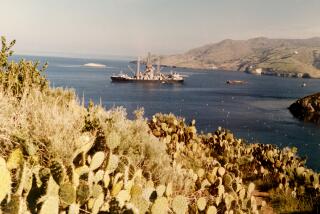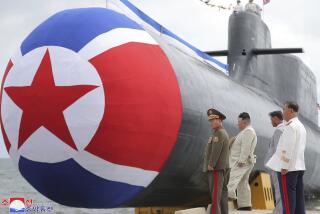Periscope of German WWII Sub Surfaces
- Share via
SAN DIEGO — From a concrete-lined shaft beneath a demolished building at a Navy base, construction workers on Thursday carefully removed a 25-foot-long cylinder of metal believed to hold the answer to a small but enduring mystery of World War II:
Whatever happened to the periscope of Unterseeboot-505, the only Nazi submarine captured on the high seas?
For nearly half a century, the U-boat has been on display at Chicago’s Museum of Science and Industry. In 1989, the 1,120-ton submarine was deemed a National Historic Monument. It is second in popularity only to the museum’s simulated underground coal mine.
But curators have long been frustrated in their attempts to discover the whereabouts of the U-505’s navigational periscope, a slender shaft of metal with optical equipment at either end.
The submarine was captured June 4, 1944, off the West African coast after a gun battle with a U.S. task force of six ships. The capture provided a bonanza of information to the U.S. and its allies about German submarine technology and communication systems.
The sub’s periscope disappeared, however, soon after it was towed to the United States. Official records offered no clue as to its whereabouts.
“I can’t tell you how many phone calls and letters I sent out in the past 13 years to find our periscope,” said Keith Gill, U-505 curator at the Chicago museum. “Then one day I get a call from San Diego: ‘We think we have something here you’d be interested in.’ ”
The answer to Gill’s quest apparently was hidden beneath Building 371 at one of the U.S. Navy’s most secret research facilities, the Arctic Submarine Laboratory.
In a group of nondescript buildings adjacent to the Point Loma submarine base, civilian and military scientists worked feverishly during the Cold War to perfect the technology necessary to operate ballistic-missile submarines beneath the polar ice cap.
The work had a sense of urgency, because the Soviet Union was thought to have an advantage.
Building 371 contained a 250,000-gallon pool of seawater that could be chilled to minus-50 degrees Fahrenheit to simulate arctic conditions.
The periscope allowed scientists in a space beneath the pool to study the performance of equipment above the waterline and to give prospective submarine skippers the simulated experience of “breaking through” the ice.
Much of the technology and expertise that allowed the U.S. to win the arctic race was perfected at Point Loma. “This is hallowed ground for arctic submarine research,” said Jeffrey A. Fischbeck, the laboratory’s retired director.
The researchers used the German periscope because it was free of charge, state-of-the-art and met their needs. There are no records to suggest how the device got to Building 371 or whether anyone knew it might have belonged to the U-505.
The answers to those questions have apparently gone to the grave with Waldo K. Lyon, for decades the laboratory’s director and a physicist and submarine innovator of renown.
Lyon’s comrades in the submarine service are also renowned for their strict adherence to a code of secrecy that discourages such queries.
“We acquired the periscope; let’s leave it at that,” said Lawrence Oblinger, 77, who worked at the laboratory from 1965 to 1990, and was on site Thursday to watch the removal.
With the end of the Cold War, and with changing military priorities, Building 371 was demolished several months ago and much of the research has been discontinued. A company hired to clear the site discovered the shaft and the periscope.
There was talk by some on the contract demolition crew that the device might fetch a fair price on EBay, where military souvenirs are hot sellers. But the Navy stepped in and invoked several laws that give it control over the periscope.
A Navy architectural historian, checking U.S. and German records, determined that the periscope was either the U-505 periscope or one so similar that the coincidence was extraordinary.
A call was made to Gill. “We were thrilled, absolutely thrilled,” he said. Since 1954, more than 23 million visitors have toured the U-505, and the Chicago museum is in the midst of a fund-raising drive to upgrade the exhibit.
On Thursday, the 1,000-pound periscope, still in working order, was loaded on a flatbed truck for the five-day trip to Chicago.
“It’s not a heavy job, but it’s a sensitive one,” said crane operator James Fox. “When you’re lifting a piece of history, it’s always a sensitive job.”
The retired lab director, Fischbeck, suggested that if the periscope could talk, it could provide answers to yet another mystery: What made the captain of the U-505 surrender rather than fight to the death, as the Fuhrer had ordered?
“He probably looked through that periscope,” Fischbeck said, “and saw way too many American forces bearing down on him with airplanes and ships.”
More to Read
Sign up for Essential California
The most important California stories and recommendations in your inbox every morning.
You may occasionally receive promotional content from the Los Angeles Times.













